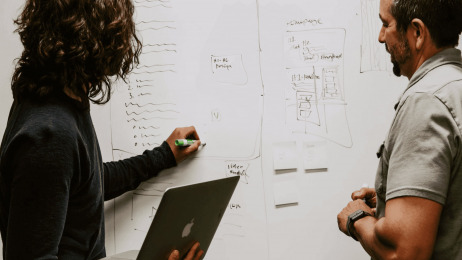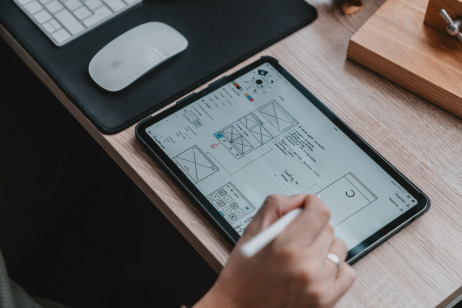
Kamil Tatol
-
Feb 20, 2023
-
5 min read
- 01 . What is the UX design process?
- 02 . How to start the UX design process
- 03 . What are the stages of the design process?
- 04 . When is the UX design process implemented?
- 05 . How long does UX design take?
- 06 . UX process vs design thinking
- 07 . What are the 7 factors of UX?
- 08 . Who do UX designers work with?
- 09 . Does UX design have a future?
- 10 . Summary
A UX design process is an essential part of creating a product. Check our practical guide to see how the practice of working in a structured approach helps make enjoyable and user-friendly products.
What is the UX design process?
The UX design process is the entire process of designing the user experience for a digital product (for more information on UX design, check the article "What is UX design and why is it important"). It consists of seven steps, starting with researching the product’s goals and its users, their needs and motivations. The process includes planning, designing, testing, iterating and implementing the product and ends with maintenance, which is constantly overseeing the product and keeping it up-to-date with industry standards.
How to start the UX design process
The UX design process should always begin with determining the scope of the project you’re working on, defining the problem you’re trying to solve or the opportunity you’re trying to seize, the product’s goals and objectives, and the target audience.
Once you know what you want to achieve with your project, you should assemble a team that includes UX researchers, UX designers, UX writers, developers, project managers, product managers, and other stakeholders. Together with the team, you can then establish a design process – a detailed roadmap that outlines each stage and how to reach it.
With a team onboard and a set plan, it’s important to have the right design tools in place, such as wireframe and prototyping tools, design software (like Adobe Photoshop, Adobe Illustrator, or Figma), and user research tools.
The phase that each UX design process should start with is UX research. Based on the gathered information and findings, UX researchers can develop user personas that will represent the target audience segments.
Once the UX design process begins, it’s important to note that it’s iterative, so you should establish a feedback loop. The team will be able to gather feedback on the design, adjust it if necessary and put it again for testing.
What are the stages of the design process?
The UX design process of creating a digital product (e.g. a website or an app) consists of seven steps: research, planning, design, testing, iteration, implementation, and maintenance.
Research
During the research phase, UX researchers collect information about the users – their needs, goal, motivations, and behaviour. They conduct various methods, such as surveys, interviews, usability testing, or card sorting (learn more about UX research and its methods in our article "What is UX research – a guide for UX researchers") and do data analysis of the findings.
Planning
The planning phase happens when the team uses the information gathered during research to plan the product design. They create a project plan and a UX strategy (we talked about it more in the "What is UX strategy?" article), outlining all the whats and hows of the process.
Design
The design phase is when the product concept gets its first shape. The design team creates product wireframes and prototypes they use later in testing. They also make the design system.
Testing
The user testing phase includes gathering feedback from the users on the initial version of the product. The team uses research methods to check whether the product fulfils user needs and it’s easy to navigate.
Iteration
After user testing, the team adjusts the product and ensures it fits better with user expectations. During this phase, the product still changes – the team may change its layout, functionality, or the general user experience.
Implementation
Once the final design has validation, the product can be implemented. Designers give developers design specification that allows for building a good, working product.
Maintenance
Once the product is launched, it moves to the ever-lasting maintenance phase. The team evaluates the product regularly by checking its performance and gathering user feedback. If there’s anything that needs an upgrade or any area that needs fixing, the team is alerted and makes necessary changes.
As we mentioned before, the UX design process is iterative. Some steps will need repetition, and sometimes the team will go back and forth between stages. The process may also differ depending on the project and the company.
When is the UX design process implemented?
The UX design process is implemented in a project that involves developing a digital product, e.g. a website, application, software or other systems. The process should be carried out from the beginning and run throughout the entire product design and development cycle. It aims to create a functional, intuitive, and enjoyable product for users. And UX design process is not only limited to new products but can also be implemented during redesigns or optimisation of already existing products.
How long does UX design take?
If you’re asking yourself how long UX design usually takes, then unfortunately, we don’t have a clear answer. The best one we can give is that it depends on the project. The time length varies depending on the product’s complexity, team size, and resource availability. One landing page may take a week or two, but a more complex digital product, like a web or mobile app, can take months to even a year to design.
Once you move to the planning phase of the UX design process, you can estimate the time for the design phase. But when it comes to the entire process – starting with research – the estimation is hard as research can often be the longest phase. Except, of course, for the ongoing maintenance phase.
It is crucial to remember that a well-executed UX design process saves time and money in the long run. The mistakes are caught early on before they become much more expensive to fix. Users are involved, so the digital product remains up-to-date with what they need. It’s time and cost-effective.
So while the time length may vary, good UX and a team that can properly execute the UX design process are key elements of making a successful product.
UX process vs design thinking
What’s the difference between the UX design process and design thinking?
The UX design process is a structured approach to creating a user-centred product. It’s a repetitive process that aims to develop a digital product like a website or an app.
Design thinking is a mindset used to create new products and innovative ideas as solutions to complex issues. It also puts the user at the centre of creating a new solution or solving a problem, but it’s not as structured as the UX process.
UX design process and design thinking differ, but they also complete each other – design thinking is crucial in the UX design process. And without the UX design process, the ideas that come from design thinking would never see the light of day.
What are the 7 factors of UX?
While many factors impact the user experience of a digital product, there are seven most important:
- Usability – how easy it is for the users to complete their tasks and accomplish their goals;
- Accessibility – how accessible the product is to people with disabilities (visual, auditory, motor, and cognitive impairments);
- Findability – how easy it is for the users to find the information they’re searching for;
- Credibility – how trustworthy and reliable the product is in terms of provided information and function;
- Aesthetics – how visually appealing the product is for the users;
- Performance – how fast and responsive the product is (including loading time and general performance);
- Utility – how useful the product is and whether it meets the needs of its users.
A good UX designer considers all those factors (and more!) and balances them out while working on a product.
Who do UX designers work with?
Or let us rephrase it: who takes part in the UX design process? Who’s part of the team? Usually, UX designers work with:
- Project managers to ensure that the project is both on schedule and on budget;
- Developers to make sure that the design is feasible and well-implemented;
- Product managers to guarantee that the product meets its goals and requirements and is aligned with the product vision;
- Researchers to base their designs on user data;
- UX writers to ensure that the content and its communication are concise and clear for the users;
- Marketing and sales staff to promote the product;
- Users to gather data from them on the product and implement necessary improvements.
They also work with stakeholders (e.g. clients or investors). There are many different people UX designers work with to make the product work and ensure that it meets the users’ and stakeholders’ needs. The team members and their roles can also vary depending on the project.
Does UX design have a future?
Technology is constantly evolving, leading to the rapid growth of UX design. As technology progresses, the need for UX design increases. We have become increasingly reliant on technology and need it to be usable – UX design help with that. The internet also becomes more inclusive, which increases the need for products to be accessible. We can also see the rise of new, emerging technologies, such as virtual or augmented reality, that will need a good UX to introduce them to the people or engage them more.
So does UX design have a future? Yes. A bright one. As technology grows, more people use the internet on mobile devices, impacting the market. Companies will need UX designers to make the products user-friendly, intuitive and enjoyable to become competitive, so UX design will very much be in demand.
Summary
A UX design process is a necessity in product design and development. As Łukasz Kowalski said: a process in UX is everything; a UX without a process is nothing. A structured approach allows for planning and project management, resulting in a successful project that has it all: a product that meets the needs of its users and stakeholders, it’s s on time and budget, and the product is competitive in the market.
- 01 . What is the UX design process?
- 02 . How to start the UX design process
- 03 . What are the stages of the design process?
- 04 . When is the UX design process implemented?
- 05 . How long does UX design take?
- 06 . UX process vs design thinking
- 07 . What are the 7 factors of UX?
- 08 . Who do UX designers work with?
- 09 . Does UX design have a future?
- 10 . Summary



















